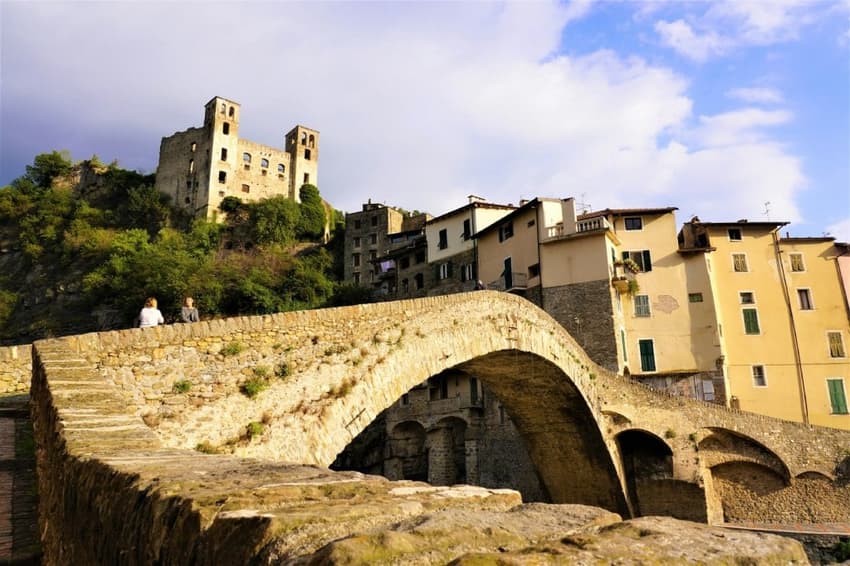Opinion
For MembersOPINION: Italy’s new digital nomads should watch out for the wifi speeds

There was excitement this week as a new digital nomad visa made the prospect of working remotely from Italy more realistic for many. But there may be a technical hitch, writes Silvia Marchetti.
Earlier this week an immigration lawyer called to tell me that the Italian government had finally implemented the digital nomad visa, which had been approved through a law a couple of years ago but was pending entry into force.
He told me he was so happy because he had a lot of foreign clients who had lined up commissions to get legal help in the application process. He said they have been waiting for years to move to Italy to work remotely.
I immediately thought that this is great news for Italy; finally foreigners longing to work remotely in a warm climate, surrounded by great views, would see their dream come true.
READ ALSO: ‘Finally!’: Excitement and doubt as Italy confirms new digital nomad visa
Then I asked myself, but why should they choose Italy over the many other European countries that already have such visa: Portugal, Croatia, the Czech Republic, Greece, Iceland, Malta, Romania, Spain, just to name some?
In the Mediterranean, Italy is surely a top destination place for digital nomads and at first people are likely to choose Italy for this over Portugal, Croatia, and Greece, just for the sake that it’s a new ‘digital destination’. All of these countries offer lower costs of living.
But the trouble with the digital nomad visa is enclosed in the first word - ‘digital’. In the short term, unless investments are made in expanding high-speed coverage, these nomads will find out that the connection in many areas of Italy is still very poor.
I live near Rome, in the countryside, and I had to forsake all internet providers because there was simply no wifi infrastructure at my place. I was forced to subscribe to Starlink, which is a satellite provider used by yachts and campers that constantly move around in isolated places like the sea, mountains, and canyons.
According to recent data from the Corte dei Conti, Italy’s public spending watchdog, half the country lacks high-speed internet because private companies don’t invest in remote rural areas and the state is lagging behind in building coverage.
Such areas have been dubbed the “White Zone”. Italy should be investing billions of euros to fill in this digital divide between rural areas and cities, and between the north (more cabled) and the south.

A man works on his laptop inside a bar. Photo by Jonathan Kemper on Unsplash
The 1 gigabit network, which is far from being super high-speed broadband, reaches just four percent of buildings and has very few subscribers.
The 5G network, at nationwide level, is still not complete, and despite commitments by the Italian government to invest the money from the European Union’s pandemic funds, we’re actually lagging behind in meeting targets to expand high-speed internet.
The appeal of relocating to a gorgeous, silent and quiet village in Sicily or Basilicata lures many digital nomads, but then once they arrive, harsh reality will kick in.
There are villages like Ollolai in Sardinia and Sambuca in Sicily that regularly host digital nomads after having invested in the upgrade of their internet infrastructure.
But the majority of small villages, and also towns and even some parts of cities, remain in very poor shape when it comes to surfing the web, sending important and urgent emails, or doing video chats and conferences.
And in cafés, bars and restaurants, even in desolate places, there’s always some kind of wifi connection, otherwise the owners themselves would have long shut.
So going for an espresso and working a couple of hours at a bar table might be an option, albeit not one sustainable in the long run for a teleworker who must always be online.
Once I was waiting for a WeTransfer with photos from a town in deep Calabria, the internet connection there was so bad that the file landed in my inbox eight hours after it had been sent. It drove me crazy.
We have the beauty of the places, the sunshine, the food, art and beaches, but when it comes to technology and investments in infrastructure some places in Africa beat us.
I remember when I visited Zanzibar for the first time on a Christmas holiday, 10 years ago, I was shocked by the ultra-speed internet I found on the island, which was much more powerful than the one I had back in Rome.
So I think that at first the digital nomad visa will be successful because Italy remains so attractive, but then when the first nomads arrive they might find themselves in desperate situations in many areas, and won’t be able to work remotely as they had thought.
I fear that word could spread through social media that Italy might not be the ideal destination for them.
The only way to avoid this situation is to quickly invest the money the government has been given by Brussels in expanding internet connection across Italy and speeding up plans for ‘digital hubs’ in rural places.
Otherwise, like my granny used to say, Italy will just end up doing “una figuraccia” - ‘making a fool of itself’ on the global stage.
Comments
See Also
Earlier this week an immigration lawyer called to tell me that the Italian government had finally implemented the digital nomad visa, which had been approved through a law a couple of years ago but was pending entry into force.
He told me he was so happy because he had a lot of foreign clients who had lined up commissions to get legal help in the application process. He said they have been waiting for years to move to Italy to work remotely.
I immediately thought that this is great news for Italy; finally foreigners longing to work remotely in a warm climate, surrounded by great views, would see their dream come true.
READ ALSO: ‘Finally!’: Excitement and doubt as Italy confirms new digital nomad visa
Then I asked myself, but why should they choose Italy over the many other European countries that already have such visa: Portugal, Croatia, the Czech Republic, Greece, Iceland, Malta, Romania, Spain, just to name some?
In the Mediterranean, Italy is surely a top destination place for digital nomads and at first people are likely to choose Italy for this over Portugal, Croatia, and Greece, just for the sake that it’s a new ‘digital destination’. All of these countries offer lower costs of living.
But the trouble with the digital nomad visa is enclosed in the first word - ‘digital’. In the short term, unless investments are made in expanding high-speed coverage, these nomads will find out that the connection in many areas of Italy is still very poor.
I live near Rome, in the countryside, and I had to forsake all internet providers because there was simply no wifi infrastructure at my place. I was forced to subscribe to Starlink, which is a satellite provider used by yachts and campers that constantly move around in isolated places like the sea, mountains, and canyons.
According to recent data from the Corte dei Conti, Italy’s public spending watchdog, half the country lacks high-speed internet because private companies don’t invest in remote rural areas and the state is lagging behind in building coverage.
Such areas have been dubbed the “White Zone”. Italy should be investing billions of euros to fill in this digital divide between rural areas and cities, and between the north (more cabled) and the south.

The 1 gigabit network, which is far from being super high-speed broadband, reaches just four percent of buildings and has very few subscribers.
The 5G network, at nationwide level, is still not complete, and despite commitments by the Italian government to invest the money from the European Union’s pandemic funds, we’re actually lagging behind in meeting targets to expand high-speed internet.
The appeal of relocating to a gorgeous, silent and quiet village in Sicily or Basilicata lures many digital nomads, but then once they arrive, harsh reality will kick in.
There are villages like Ollolai in Sardinia and Sambuca in Sicily that regularly host digital nomads after having invested in the upgrade of their internet infrastructure.
But the majority of small villages, and also towns and even some parts of cities, remain in very poor shape when it comes to surfing the web, sending important and urgent emails, or doing video chats and conferences.
And in cafés, bars and restaurants, even in desolate places, there’s always some kind of wifi connection, otherwise the owners themselves would have long shut.
So going for an espresso and working a couple of hours at a bar table might be an option, albeit not one sustainable in the long run for a teleworker who must always be online.
Once I was waiting for a WeTransfer with photos from a town in deep Calabria, the internet connection there was so bad that the file landed in my inbox eight hours after it had been sent. It drove me crazy.
We have the beauty of the places, the sunshine, the food, art and beaches, but when it comes to technology and investments in infrastructure some places in Africa beat us.
I remember when I visited Zanzibar for the first time on a Christmas holiday, 10 years ago, I was shocked by the ultra-speed internet I found on the island, which was much more powerful than the one I had back in Rome.
So I think that at first the digital nomad visa will be successful because Italy remains so attractive, but then when the first nomads arrive they might find themselves in desperate situations in many areas, and won’t be able to work remotely as they had thought.
I fear that word could spread through social media that Italy might not be the ideal destination for them.
The only way to avoid this situation is to quickly invest the money the government has been given by Brussels in expanding internet connection across Italy and speeding up plans for ‘digital hubs’ in rural places.
Otherwise, like my granny used to say, Italy will just end up doing “una figuraccia” - ‘making a fool of itself’ on the global stage.
Join the conversation in our comments section below. Share your own views and experience and if you have a question or suggestion for our journalists then email us at [email protected].
Please keep comments civil, constructive and on topic – and make sure to read our terms of use before getting involved.
Please log in here to leave a comment.